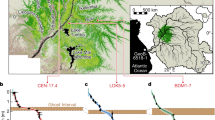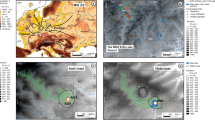Abstract
Most of Beauchêne Island in the South Atlantic is covered by tussac, the tussock-forming grass Poa flabellata (Lam.) Rasp., which has produced a deep accumulation of exceptionally dense peat during ∼12,500 yr. The basal peat is lignitic, yet it is several hundred times too young to be a true lignite. During an ecological survey of the island in December 19801, one of us (R.I.L.S.) sampled an 11-m high peat face. The age against depth profile in the peat is consistent with a constant proportional rate of decay of 1.1–2.2×10−4 yr−1 and a constant rate of addition of dry matter to the peat of 430–720 g m−2 yr−1. This rate of decay is within the range recorded for peats in corresponding latitudes in the Northern Hemisphere, but the rate of addition of dry matter is about 10 times as great. This is not easy to accommodate within current hypotheses about peat formation. An unusual combination of biological, physical and chemical circumstances may be the cause. As the island is difficult to visit and no more information can be obtained in the near future, we now report these results, incomplete though they are.
This is a preview of subscription content, access via your institution
Access options
Subscribe to this journal
Receive 51 print issues and online access
$199.00 per year
only $3.90 per issue
Buy this article
- Purchase on Springer Link
- Instant access to full article PDF
Prices may be subject to local taxes which are calculated during checkout
Similar content being viewed by others
References
Strange, I. J. Polar Rec. 12, 725–730 (1965).
Smith, R. I. L. & Prince, P. A. Biol. J. Linn. Soc. (in the press).
Clymo, R. S. in Ecosystems of the World Vol. 4A (ed. Gore, A. J. P.) 159-224 (Elsevier, Amsterdam, 1983).
Clymo, R. S. Phil. Trans. R. Soc. B303, 605–654 (1984).
Gunn, T. C. thesis, Univ. Manchester (1976).
Smith, R. I. L. in Antarctic Nutrient Cycling and Food Webs (eds Siegfried, W. R., Condy, P. & Laws, R. M.) (Springer, Berlin, in the press).
Smith, R. I. L. Bull. Br. Antarct. Surv. 53, 119–139 (1981).
Walton, D. W. H. in Antarctic Nutrient Cycling and Food Webs (eds Siegfried, W. R., Condy, P. & Laws, R. M.) (Springer, Berlin, in the press).
Waughman, G. J. J. Ecol. 68, 1025–1046 (1980).
Clark, R. M. Antiquity 49, 251–266 (1975).
Author information
Authors and Affiliations
Rights and permissions
About this article
Cite this article
Smith, R., Clymo, R. An extraordinary peat-forming community on the Falkland Islands. Nature 309, 617–620 (1984). https://doi.org/10.1038/309617a0
Received:
Accepted:
Issue Date:
DOI: https://doi.org/10.1038/309617a0
This article is cited by
Comments
By submitting a comment you agree to abide by our Terms and Community Guidelines. If you find something abusive or that does not comply with our terms or guidelines please flag it as inappropriate.



